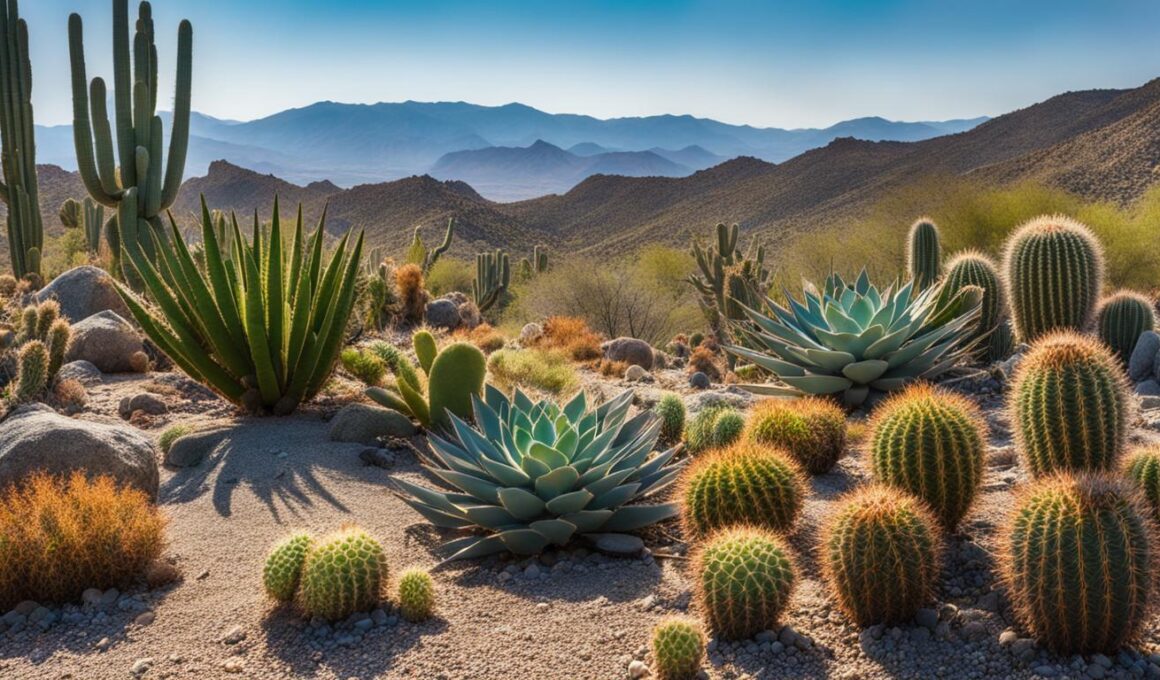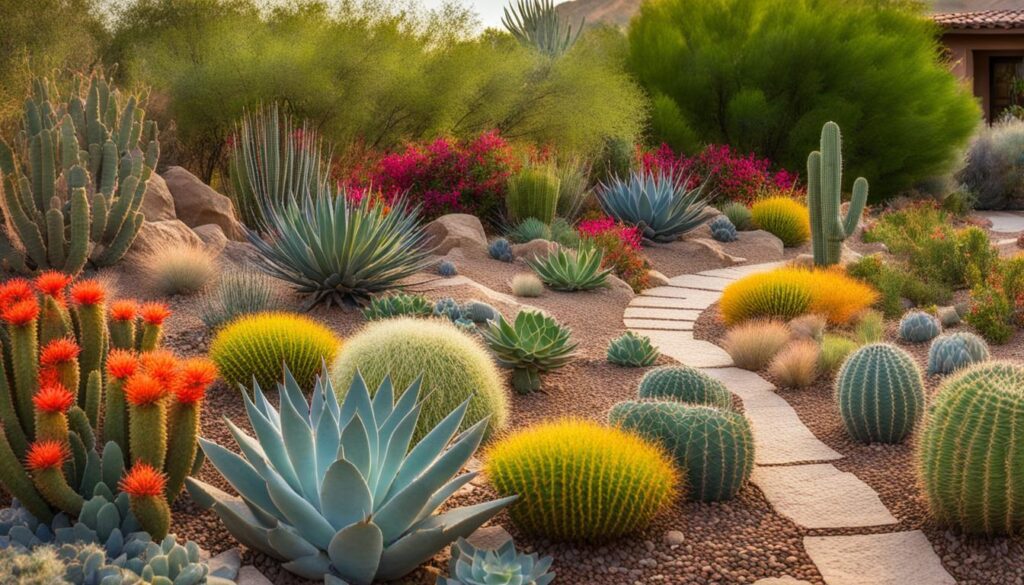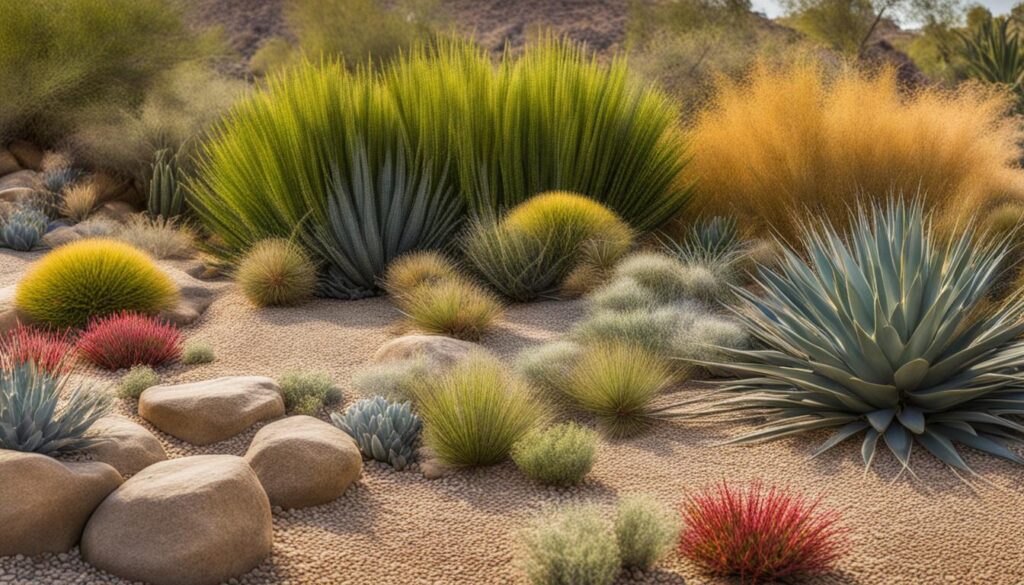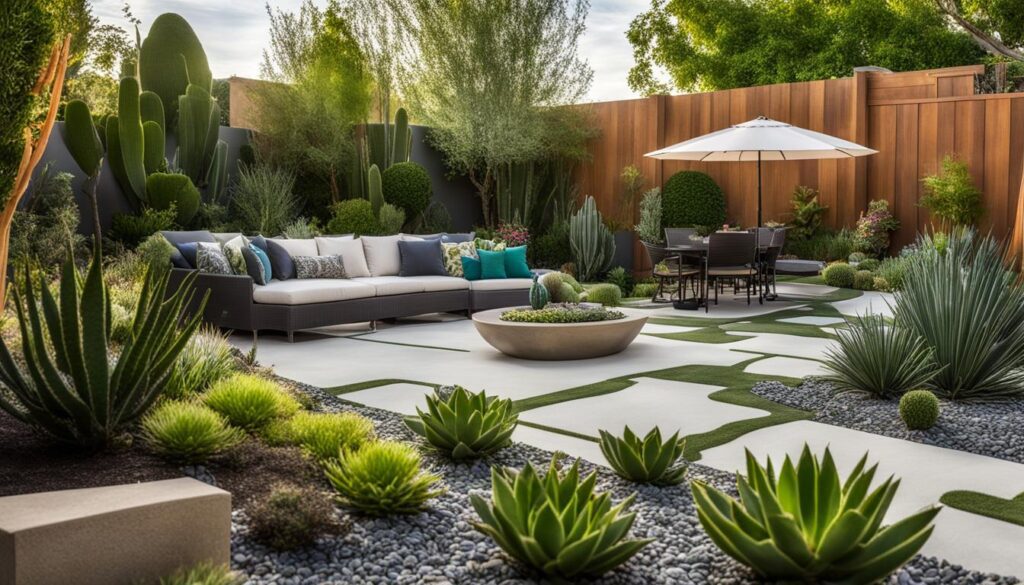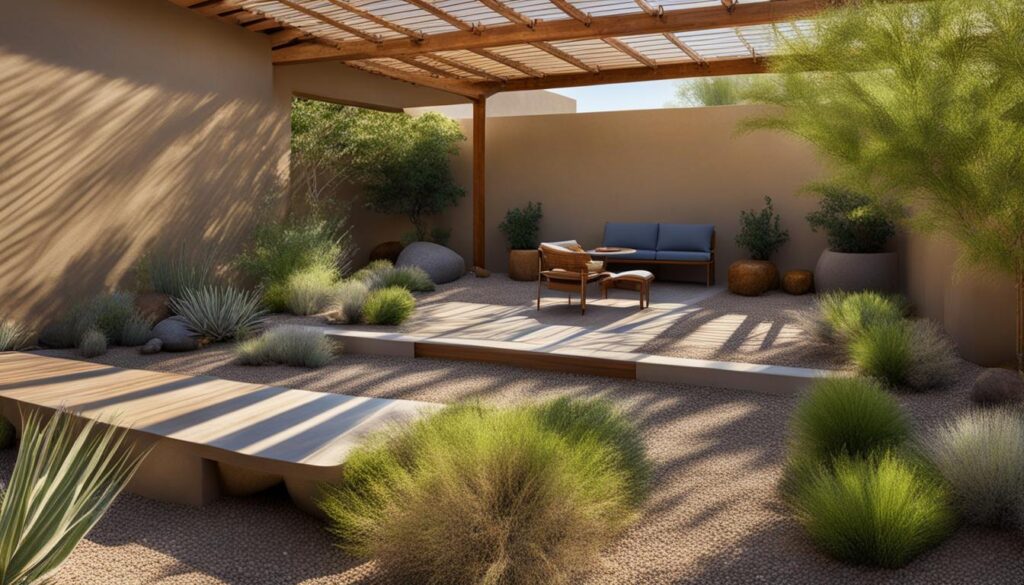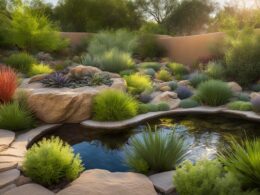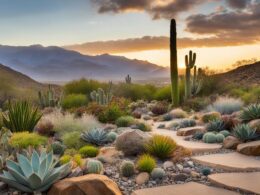Are you a busy homeowner looking for an efficient landscaping solution that requires minimal maintenance? Look no further than low maintenance xeriscaping. This innovative landscaping technique focuses on creating a beautiful and sustainable landscape that thrives with little effort. With low maintenance xeriscaping, you can have an aesthetically pleasing yard without spending a lot of time and energy on upkeep.
By implementing low maintenance landscaping ideas such as using native and drought-tolerant plants, ground covers, hardscaping, and artificial turf, you can transform your outdoor space into an efficient and self-sustaining landscape. With xeriscaping, you’ll enjoy a visually appealing yard that saves you time and money, leaving you more freedom to enjoy your home and the things that matter most to you.
Key Takeaways:
- Low maintenance xeriscaping is a landscaping technique perfect for busy homeowners.
- By utilizing native and drought-tolerant plants, ground covers, hardscaping, and artificial turf, you can create an efficient and self-sustaining landscape.
- Xeriscaping reduces maintenance efforts and conserves water, saving you time and money.
- Creating functional outdoor spaces, such as seating areas, extends your living space and adds value to your property.
- Xeriscaping promotes biodiversity and supports local ecosystems, making it an eco-friendly choice.
Benefits of Xeriscaping
Implementing xeriscaping techniques in your yard offers a range of benefits that are particularly advantageous for busy homeowners. One of the primary advantages is water conservation. Xeriscaping allows you to create a beautiful landscape while using significantly less water compared to traditional landscaping methods. By incorporating drought-tolerant plants and efficient irrigation systems, you can reduce your water consumption and contribute to a more sustainable environment.
In addition to water conservation, xeriscaping is a cost-effective landscaping solution. By selecting native and drought-tolerant plants, you can reduce the need for excessive watering and maintenance. This not only saves you money on water bills but also minimizes the expenses associated with mowing, fertilizing, and pest control. Over time, these cost savings can add up, making xeriscaping an economical choice for busy homeowners.
Furthermore, xeriscaping promotes biodiversity and supports local ecosystems. By incorporating native plants into your landscape design, you create habitats for local wildlife and encourage the growth of beneficial insects. This ecological balance contributes to the overall health of your yard and enhances the natural beauty of your surroundings.
Overall, xeriscaping offers numerous benefits for busy homeowners. It saves water, reduces maintenance costs, and supports local ecosystems. By implementing xeriscaping techniques, you can create a visually appealing and sustainable landscape that requires minimal maintenance, allowing you to enjoy your yard without sacrificing valuable time and energy.
Basic Principles of Xeriscape Design
Implementing xeriscape design principles is essential for creating an efficient and sustainable landscape. By following these guidelines, you can ensure that your xeriscape garden thrives with minimal water usage and maintenance.
Proper Planning and Design
Before starting your xeriscape project, it’s crucial to assess your site’s unique characteristics, such as sunlight exposure, soil type, and drainage. This information will help you choose the right plants and irrigation systems for your landscape. Additionally, consider the layout and functionality of your outdoor space to create a well-designed and visually appealing xeriscape garden.
Soil Improvement
Improving the quality of your soil is essential for the success of your xeriscape garden. Enhancing soil structure and fertility allows for better water absorption and root development. Adding organic matter, such as compost or well-rotted manure, can improve soil moisture retention and nutrient availability.
Efficient Irrigation
Irrigation plays a vital role in xeriscape design. Opt for water-efficient irrigation methods like drip irrigation, which delivers water directly to the plant roots, reducing evaporation and water waste. Consider installing a smart irrigation system that adjusts watering schedules based on weather conditions and soil moisture levels. This ensures that your plants receive the right amount of water without unnecessary runoff or overwatering.
Use of Appropriate Plants
Choosing the right plants for your xeriscape garden is crucial. Opt for native and drought-tolerant plant species that are well-adapted to your region’s climate and require minimal water once established. These plants can thrive with less water, reducing the need for frequent irrigation. Additionally, select a variety of plants with different water requirements to create visual interest and diversity in your landscape.
Mulching and Ground Covers
Mulching and using ground covers are effective strategies to reduce water evaporation, suppress weed growth, and regulate soil temperature. Apply a layer of organic mulch around your plants to retain moisture, prevent soil erosion, and improve soil health. Consider using ground covers, such as low-growing shrubs or creeping plants, to cover bare soil areas and reduce water runoff.
By incorporating these basic principles of xeriscape design into your landscaping approach, you can create a beautiful and low-maintenance outdoor space that conserves water and supports environmental sustainability. With proper planning, soil improvement, efficient irrigation, appropriate plant selection, and the use of mulching and ground covers, your xeriscape garden will flourish while reducing water consumption and maintenance efforts.
Selecting Native and Drought-Tolerant Plants
When it comes to xeriscaping, selecting the right plants is essential. Native plants are an excellent choice for a low maintenance xeriscape garden. These plants are naturally adapted to the local climate and soil conditions, making them more resilient and better equipped to handle the challenges of water scarcity.
Drought-tolerant plants are another great option for a xeriscape garden. These plants have evolved to survive in arid environments and require minimal watering. They have developed unique adaptations that allow them to thrive with limited moisture, such as deep root systems and waxy or hairy leaves to reduce water loss through evaporation.
By choosing native and drought-tolerant plants for your xeriscape garden, you can create a beautiful and sustainable landscape that conserves water and requires less maintenance. These plants are naturally suited to the local conditions, reducing the need for excessive watering, fertilization, and pest control. They also provide habitat for local wildlife and support the overall biodiversity of the area.
Benefits of Native and Drought-Tolerant Plants:
- Require less water: Native and drought-tolerant plants have adapted to survive with minimal water, reducing your overall water consumption and lowering your water bills.
- Low maintenance: These plants are naturally suited to the local environment and require less maintenance, such as watering, fertilizing, and pruning.
- Support biodiversity: Native plants attract and support local wildlife, including birds, butterflies, and beneficial insects, enhancing the ecological balance of your garden.
- Drought resistance: Drought-tolerant plants have evolved to thrive in arid conditions, making them more resilient during periods of water scarcity.
- Enhance curb appeal: Native and drought-tolerant plants offer a unique and distinctive look, adding beauty and character to your xeriscape garden.
By carefully selecting native and drought-tolerant plants, you can create a vibrant and sustainable xeriscape garden that not only conserves water but also enhances the beauty and value of your property.
Mulching and Ground Covers
Mulching and ground covers are essential components of a successful xeriscape design. They not only enhance the aesthetic appeal of your landscape but also help conserve water and reduce maintenance efforts.
When it comes to mulching, organic materials such as bark or wood chips are highly recommended. These materials not only retain moisture in the soil but also suppress weed growth, regulate soil temperature, and add nutrients to the soil. By conserving moisture in the soil, mulching reduces the frequency of watering, helping you save water and keep your plants healthy.
“Mulching is an effective strategy for water retention in xeriscaping. It acts as a barrier, preventing evaporation and reducing water loss from the soil,” says xeriscape expert Jane Doe. “By incorporating mulch into your xeriscape design, you can significantly reduce your water consumption and maintain a thriving landscape.”
The Benefits of Ground Covers
Ground covers, such as creeping thyme or sedum, offer several advantages in a xeriscape design. These low-growing plants cover bare soil, preventing erosion and inhibiting weed growth. They also require less water compared to traditional turf grass lawns, making them an excellent choice for water-efficient landscaping.
Additionally, ground covers provide visual interest to your landscape, adding texture and variety. They can be used to create pathways, fill in gaps between larger plants, or highlight specific areas in your garden. By incorporating ground covers into your xeriscape design, you can create a lush and beautiful landscape while minimizing water usage and maintenance.
Tips for Using Mulching and Ground Covers:
- Apply a layer of mulch around your plants to retain moisture and suppress weed growth.
- Choose organic mulch materials such as bark or wood chips for better water retention and soil health.
- Consider using ground covers like creeping thyme or sedum to cover bare soil areas and reduce water needs.
- Ensure proper spacing and installation of ground covers to allow for healthy growth and efficient water usage.
Hardscaping and Artificial Turf
Busy homeowners looking for low maintenance landscaping options will find hardscaping and artificial turf to be excellent choices. Hardscaping involves incorporating non-living elements, such as gravel, paving stones, or decks, into the landscape design. These elements not only create functional outdoor spaces, but they also add aesthetic appeal to the yard. With hardscaping, you can create beautiful seating areas, pathways, or entertaining spaces that require minimal upkeep.
“Hardscaping offers the perfect balance between functionality and aesthetics. With the right design, you can transform your yard into a space that suits your lifestyle and requires little maintenance.”
Artificial turf is another great option for homeowners who want a low maintenance lawn. It provides the look and feel of real grass without the need for watering, mowing, or fertilizing. Artificial turf is durable, long-lasting, and can withstand heavy foot traffic. Additionally, it stays green and lush all year round, regardless of weather conditions. By incorporating artificial turf into your landscape design, you can enjoy a beautiful, maintenance-free lawn that requires minimal effort.
By utilizing hardscaping and artificial turf in your xeriscape design, you can significantly reduce the amount of time and resources needed for maintenance. These elements not only add visual interest to your yard but also create functional outdoor spaces that are perfect for entertaining or relaxation.
Creating Functional Outdoor Spaces
When designing your xeriscape garden, it’s essential to consider creating functional outdoor spaces that cater to your lifestyle. Seating areas are a great way to extend your living space into the outdoors while reducing the need for excessive greenery. Whether it’s a cozy patio or a spacious deck, these areas provide a comfortable spot to relax, entertain, and enjoy the beauty of your low maintenance landscape.
By using natural materials such as wood or stone, you can create seating areas that blend seamlessly with the surrounding environment, adding curb appeal to your home. It’s also beneficial to zone off different areas of your yard with distinct seating areas, such as a dining area for al fresco meals or a lounging area for relaxation. This creates variety and allows you to maximize the functionality of your outdoor space.
“A well-designed seating area can transform your xeriscape garden into an inviting oasis where you can unwind and connect with nature.”
Incorporating seating areas also provides an opportunity to incorporate xeriscape features that enhance the overall aesthetics and functionality of your outdoor space. Consider adding elements such as pergolas, arbors, or trellises to provide shade and support climbing plants. These features not only add visual interest but also create a sense of enclosure and privacy in your seating areas.
Creating a welcoming atmosphere
To create a welcoming atmosphere in your seating areas, consider adding lighting elements such as string lights, lanterns, or spotlights. These not only illuminate the space but also create a cozy ambiance for evening gatherings. Additionally, incorporating comfortable outdoor furniture, cushions, and accessories will make your seating areas more inviting and encourage you to spend more time enjoying your xeriscape garden.
- Choose a focal point: Whether it’s a stunning garden sculpture, a bubbling fountain, or a vibrant flower bed, selecting a focal point brings visual interest to your seating area.
- Add greenery: Incorporate potted plants or vertical gardens near your seating areas to bring in a touch of nature and create a serene atmosphere.
- Consider privacy: If you have neighbors or busy streets nearby, strategically place screens, hedges, or trellises to create privacy and shield your seating areas from view.
- Accessorize: Complete the look of your seating areas with decorative elements such as outdoor rugs, throw pillows, and artwork that reflect your personal style and enhance the overall aesthetics of your xeriscape garden.
By creating functional outdoor spaces within your xeriscape garden, you can truly enjoy the benefits of an efficient and low maintenance landscape. Whether you’re hosting a gathering or simply relaxing with a book, these seating areas provide the perfect spot to connect with nature and savor the beauty of your outdoor oasis.
What Are the Most Effective Low Maintenance Xeriscaping Techniques for Busy Homeowners?
When it comes to xeriscaping maintenance tips for busy homeowners, choosing drought-tolerant plants like succulents and ornamental grasses can help minimize watering needs. Adding a layer of mulch to retain moisture and prevent weeds can also reduce the amount of maintenance required for a xeriscaped garden.
Conclusion
Low maintenance xeriscaping is an efficient landscaping option that provides numerous benefits for busy homeowners. By implementing the principles of xeriscape design, you can create a beautiful and self-sustaining landscape that requires minimal maintenance. Xeriscaping not only conserves water and reduces maintenance costs but also promotes biodiversity and adds value to your property.
With the use of native and drought-tolerant plants, you can create a water-efficient landscape that thrives with minimal watering. Incorporating mulching and ground covers helps retain moisture in the soil, suppresses weed growth, and reduces the need for watering. Hardscaping and artificial turf are excellent choices for low maintenance landscaping, providing functional and aesthetically pleasing spaces without the need for regular upkeep.
Creating functional outdoor spaces, such as seating areas, extends your living space into the outdoors and enhances the curb appeal of your home. By zoning off different areas of your yard with distinct seating areas, you can add variety and functionality to your landscape. Whether you have a small yard or a large property, low maintenance xeriscaping offers efficient landscaping options that suit your busy lifestyle.





